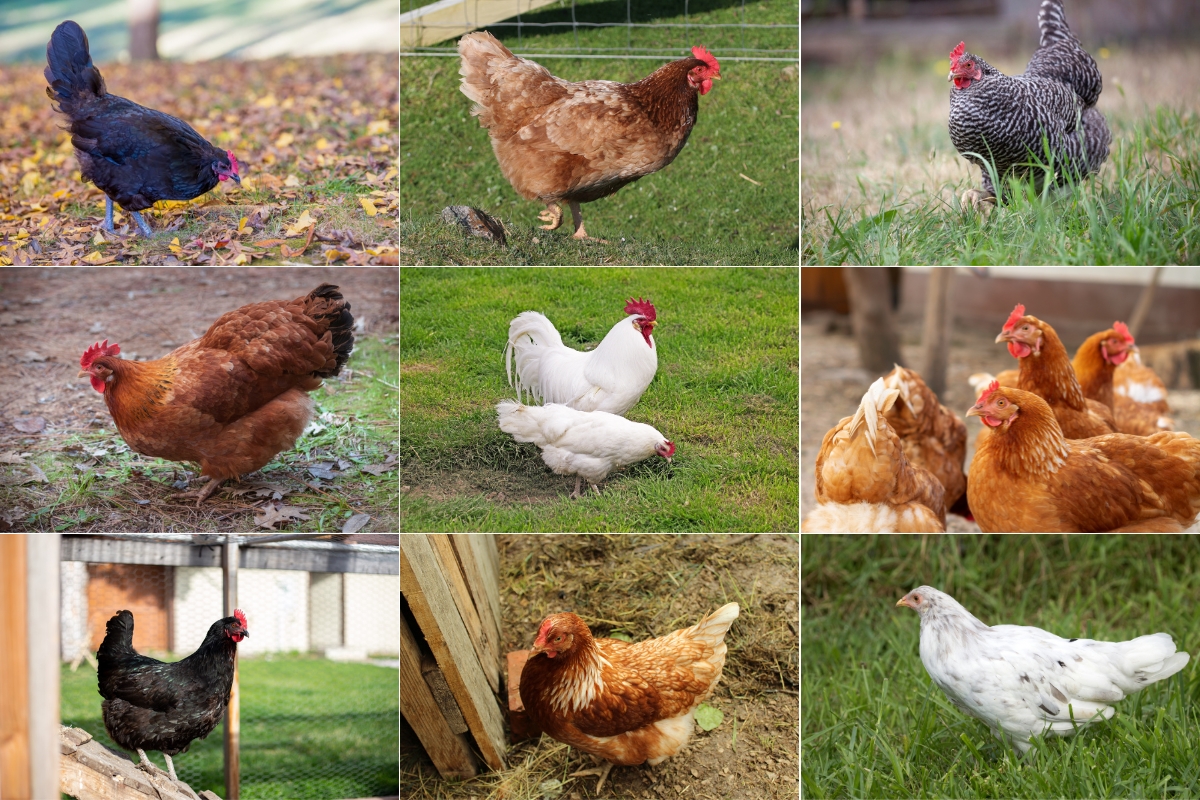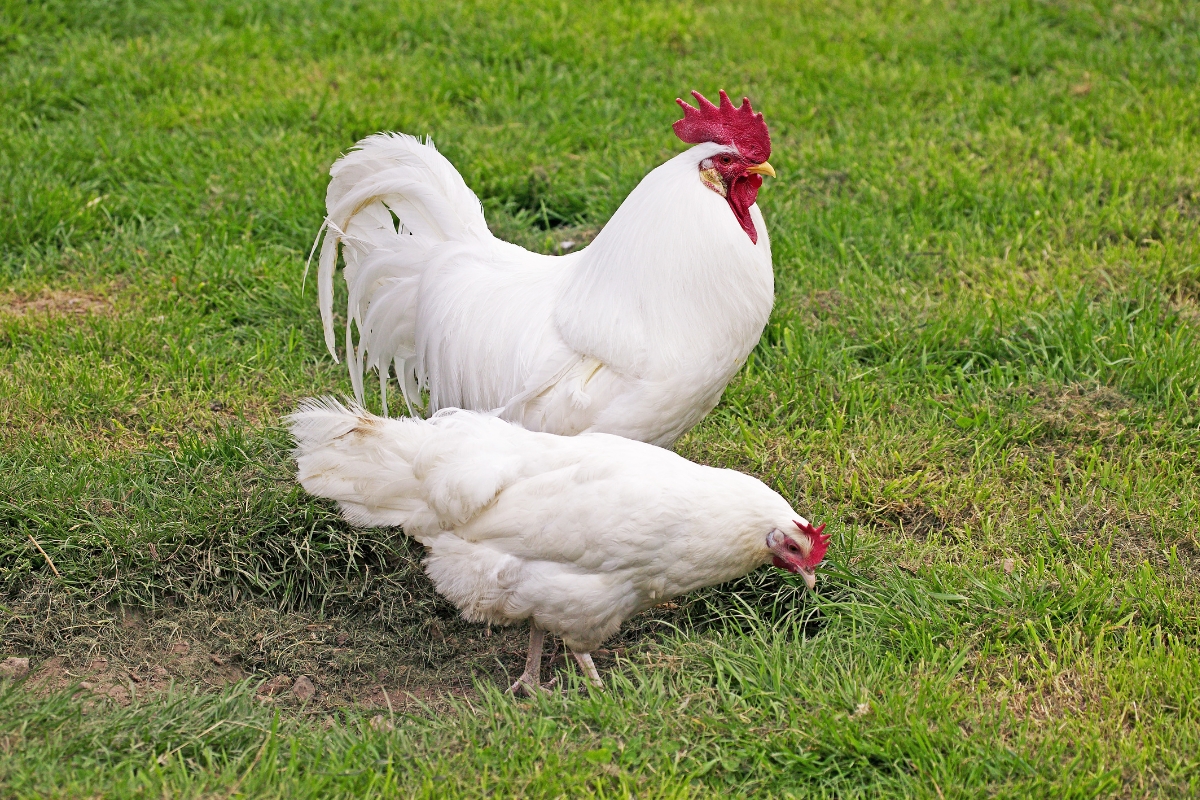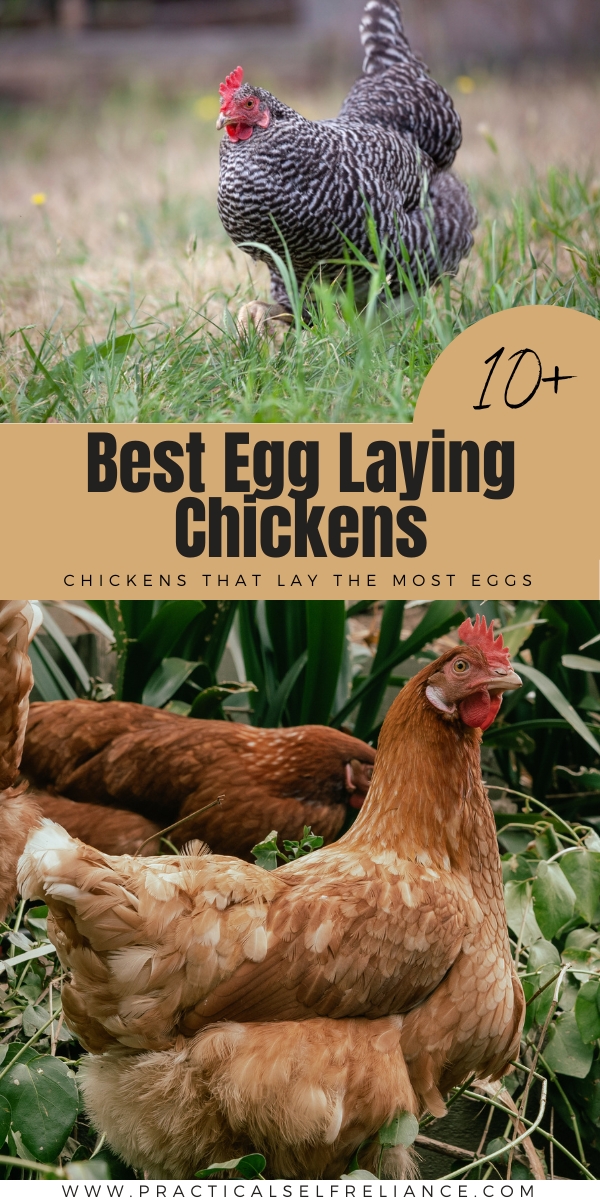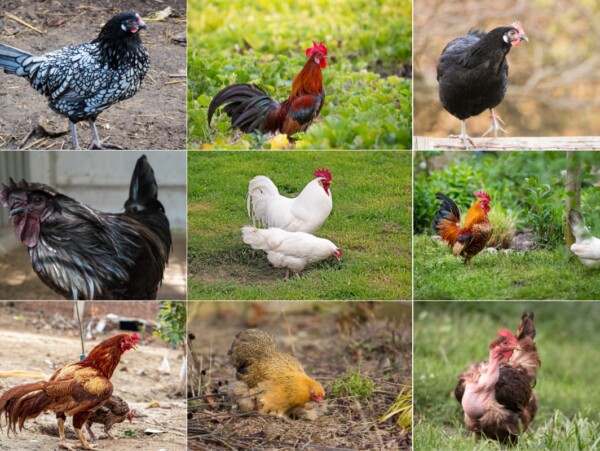Affiliate disclosure: This post may contain affiliate links. Please see our Privacy Policy.
Chickens that lay the most eggs are the perfect choice when you want to keep your feed costs down, while harvesting plenty of eggs at home. These breeds were developed to produce as many eggs as possible, but each has its pros and cons.

This article is written by Rea Yoh, a freelance writer who grew up in rural Illinois, raising backyard chickens. She graduated with honors in Biology and Science, Technology, and Society from Brown University, and her background in research helps her get to the heart of any question. She has a passion for animals, the environment, and sustainable living.
There’s nothing quite like collecting fresh eggs from your very own backyard chickens– home-harvested eggs are delicious and nutritious. One of the greatest perks to owning chickens is getting eggs, especially if you’re omelet-obsessed or are looking to start your own egg-selling business. But with so many different types of chickens to choose from, how do you decide which ones are the best egg layers?
If you’re prioritizing egg production over all other factors, this is the guide for you.
Keep in mind, when you boost egg production, it often means sacrificing other characteristics like friendliness and foraging ability. Some of these breeds still still maintain those traits, but others are best simply for commercial production. That said, if you’re just keeping chickens in a coop and not hoping to snuggle them as backyard pets, that might not matter, and a semi-commercial breed might actually be the best choice.
As a beginning chicken keeper, you might want to take a look at my list of the best egg laying chickens for beginners.
Chickens That Lay the Most Eggs
Some of the chickens in this article are hybrids and don’t have breed standards. Some hybrids breed true, meaning they keep the characteristics of their parents, while some don’t– they require very specific parent crosses or they won’t be considered a true hybrid with the same egg-laying potential. Nevertheless, they all have very different appearances, personalities, and strengths.
What unites them all is their ability to lay tons of eggs, and you can’t make a wrong choice! Be warned, though–you might have to clear lots of space on your countertop to make room for all of the eggs you’ll be collecting!
I’ve broken the breeds down into two groups, starting with the purebreds that will breed true and will allow you to maintain a self-sustaining flock (with an incubator). None of these breeds are broody, which is good, as going broody drops egg production…but you will need to hatch eggs in an incubator if you hope to hatch your own next generation.
These breeds of chicken lay lots of eggs and breed true, generation after generation:
- White leghorn
- Rhode Island Red
- Barred Rock
- Australorp
- Whiting True Blue
There are a number of hybrid chickens that don’t breed true, and only lay lots of eggs in the first generation. They’re a mix of two existing breeds, with a hen from one breed and a rooster from another, and they’ll only produce for the 1st generation. These hybrids can be purchased from hatcheries to replenish your stock every few years.
Hybrid chickens that lay a lot of eggs include:
- Bovan
- Golden Comet
- Lohmann Brown
- Isa brown
- Black Star
I’ll cover the pros and cons of each, one by one.
White Leghorn
The iconic white leghorn is probably the first bird that comes to mind when you think of “chicken”. These are your classic snow-white fowl with red wattles and yellow legs. If you’re looking for a bird with an outstanding feed-to-egg ratio that never goes broody, a white leghorn is perfect for you. The white leghorn is a superb egg-laying breed and is the foundation for most of the modern commercial egg industry, laying up to 320 eggs per year! The standard white eggs you get from the grocery store are almost always from a leghorn or leghorn cross.
White leghorns start laying at an early age, around four to five months, and lay well into their third years. White leghorn breeders have prioritized productivity over friendliness. These birds are geared towards homesteaders who aren’t looking for a very cuddly chicken, as they can be fearful and high-energy. That being said, they’re still lots of fun to observe!
If you’d like to learn more, check out my White Leghorn Breed Guide.
- Breed Name: White Leghorn
- Breed Type: Egg-Laying Breed
- Temperament: Flighty, nervous, agressive toward other breeds
- Size: large roosters: 3.4 kg (7.5 lbs); large hens: 2.7 kg (6 lbs); Bantam rooster: 1 kg (2.2 lb); bantam hen: 0.9 kg (1.98 lbs)
- Eggs Per Year: 280-320
- Egg Size: Large
- Egg Color: White
- Feather Type: Standard
- Comb Type: Single comb
- Hardiness: Heat tolerant, but not the best in cold
- Lifespan: 5-7 years
- Time To Maturity: 18-20 weeks

Rhode Island Red
The ever-popular Rhode Island Red easily makes the list for one of the prolific egg-laying chicken breeds. The Rhode Island Red is a dual-purpose bird, used for both meat and eggs. Starting in the 1940s, breeders attempted to maximize its egg laying capacity. Among the breeds standardized by the American Poultry Association, it is one of the best layers and contributes to a lot of commercial chicken hybrid lines. Heritage Rhode Island Reds will lay between 200-300 eggs per year. Production Reds will lay 280-300. They start laying at a relatively early age, approximately 18 weeks. Depending on the type of Red that you choose, they will lay for two or three years. Production lines lay more eggs but for a fewer number of years.
Full of personality and life, Rhode Island Reds are happy wherever they are, whether that be in confinement or exploring your lawn. They’re lively and loud. Their high energy makes them a bit aggressive towards more docile breeds, so make sure to be aware of this if you have gentler birds.
- Breed Name: Rhode Island Red
- Breed Type: Dual Purpose, but Primarily Egg Laying
- Temperament: Active, curious
- Size: Medium, 6-10 lbs
- Eggs Per Year: 200-300
- Egg Size: Medium to large
- Egg Color: Light brown
- Feather Type: Standard
- Comb Type: Single or Rose Comb
- Hardiness: Cold hardy and heat tolerant
- Lifespan: Five to six years or more
- Time To Maturity: 18 weeks

Barred Rock
The Barred Rock is a backyard chicken staple. A Barred Rock hen is a very hardworking layer, despite being a dual-purpose breed, and are one of the best types of chicken for egg production. A Barred Rock will lay 280-300 eggs per year. Hens reach maturity early, at 18-20 weeks, and lay for a good portion of their lives, about 2-3 years.
- Breed Name: Barred Rock (or Plymouth Rock)
- Breed Type: Egg-Laying Breed
- Temperament: Docile, gentle
- Size: Medium, 6-7 lbs
- Eggs Per Year: 280-300
- Egg Size: Medium to large
- Egg Color: Brown
- Feather Type: Standard
- Comb Type: Single Comb
- Hardiness: Cold hardy and heat tolerant
- Lifespan: Up to 8 years
- Time To Maturity: 18 weeks

Australorp
This gorgeous bird hails from Australia, hence the “Austra-” part of its name. A cross between Black Orpingtons, Rhode Island Reds, and White Leghorns, the Australorp is a very productive egg-laying breed. A Black Australorp hen can lay up to 300 eggs per year. They’re hardy and do well in many climates and types of spaces, making them a perfect hands-off breed.
Not only are these fowl beautiful to look at with their glossy plumage, they are also friendly. They’re calm and make great companions. At first, your Australorp might be a bit shy, but don’t worry! They’ll warm up to you quickly.
- Breed Name: Australorp
- Breed Type: Dual Purpose Breed
- Temperament: Calm, easygoing
- Size: Large, 6-10 lbs
- Eggs Per Year: 250-300
- Egg Size: Medium to large
- Egg Color: Light brown
- Feather Type: Standard
- Comb Type: Single Comb
- Hardiness: Cold hardy and heat tolerant
- Lifespan: Eight years or more
- Time To Maturity: 20 to 22 weeks

Whiting True Blue
If you’re looking to add a bit of color to your egg basket, the Whiting True Blue is what you’re looking for. This hybrid wasn’t created for eggs, surprisingly, yet they are some of the best layers out there. Whiting True Blues produce 250-300 eggs per year. They also lay well into their third years, which is unheard of for chickens that are so prolific. Whiting True Blues also breed true, so your chicks will also be True Blues.
Though they are technically still considered a “hybrid” breed, since they’re relatively new, they have stabilized already and do breed true. They’re just not officially recognized as a breed yet, but that will likely change soon.
These beautiful birds come in a rainbow of colors–wheaten, blue, red, and more–and their blue eggs are just as eye-catching. If you want a hands-off chicken that’s resourceful, active, and can fend for itself, Whiting True Blues are a great option. Their leghorn ancestry gives them a fiery personality, making them great foragers.
- Breed Name: Whiting True Blue
- Breed Type: Egg-Laying Breed
- Temperament: Independent, active, sometimes aggressive
- Size: Medium, 5-7 lbs
- Eggs Per Year: 250-300
- Egg Size: Medium to large
- Egg Color: Blue
- Feather Type: Standard
- Comb Type: Pea Comb
- Hardiness: Cold hardy and heat tolerant
- Lifespan: Five years or more
- Time To Maturity: 20 weeks

Hybrid Egg Laying Chicken Breeds
These breeds lay incredible amounts of eggs each year, and consume very little feed relative to other breeds. They are first generation hybrids, however, and they won’t breed true.
If you’re willing to purchase new stock from the hatchery every few years (as most people do anyway), then these breeds are a great way to get the most eggs possible.
Bovans
Developed in 1954, Bovans are a relatively new breed of layer, and an absolute powerhouse. Designed to be an optimal production chicken, Bovans eat relatively little feed and produce over 300 eggs per year. They do exceptionally well in confinement–free range Bovans actually lay fewer eggs than their colony counterparts. These birds are also very robust and can tolerate a variety of living conditions, as long as their basic needs are met. That being said, I am a huge proponent of giving backyard chickens the ability to roam and forage freely.
Bovans have specific parent stock, which you can obtain from the Bovans company.
The Bovans comes in a few different varieties–black, white, goldline and brown. Bovans Brown, White, and Goldline are the best layers, but blacks aren’t too far behind. On top of their productivity, Bovans are also good family pets, as they’re a lot more easygoing than other productive breeds. If you want an incredible layer that’s easy to keep, go for a Bovans.
- Breed Name:Bovans
- Breed Type: Egg-Laying Breed
- Temperament: Gentle, patient, docile
- Size: Small, 4-5 lbs
- Eggs Per Year: 290-300+
- Egg Size: Medium to large
- Egg Color: Dark brown
- Feather Type:
- Comb Type:
- Hardiness:
- Lifespan: Up to 8 years
- Time To Maturity: 18 weeks

Golden Comet
With a name like “Golden Comet”, it’s no surprise that this crossbreed is something special. Specifically developed for egg laying, the Golden Comet is a superstar chicken for homesteaders wanting lots of eggs. They have many names, including Cinnamon Queen, Red Star, Golden Buff, and Gold Sex Link. Regardless of what you call them, Golden Comets are an excellent choice for a homesteader wanting to maximize the number of eggs they get each day. They lay around 330 medium to large brown eggs per year.
Golden Comets are the result of breeding a New Hampshire rooster with a White Rock hen. These aren’t true-breeding, so a Golden Comet hen will not produce Golden Comet chicks.
Golden Comets reach egg laying age at 16 weeks, which is very early. Commercial Golden Comets do not go broody, as they have the trait bred out of them. They get along well with people and other chickens, as well. Because they’re so good at laying, they have a relatively short lifespan and live around four to five years, although some chickens can certainly live for longer. Another plus to Golden Comets is that they’re sex-linked; you can tell females and males apart from day one.
- Breed Name:
- Breed Type: Egg-Laying Breed
- Temperament: Personable, friendly
- Size: Small, 4 lbs (hens), 6 lbs (roosters)
- Eggs Per Year: 300-330
- Egg Size: Medium to large
- Egg Color: Light brown
- Feather Type:
- Comb Type:
- Hardiness:
- Lifespan: 4-5 years
- Time To Maturity: 16 weeks

Lohmann Brown
If you eat eggs every day, consider adding the Lohmann Brown to your flock. A cross between New Hampshires and certain strains of brown layers, the Lohmann Brown was developed in Germany and was one of the first crossbreeds created for the egg industry. These dainty birds prove that good things come in small packages, producing a whopping 380 eggs per year!
If you’re looking for a chicken that’s both a great layer and easy to keep, Lohmann Browns are a great choice if you’re new to backyard chickens. They’re relatively small and don’t consume a lot of feed, yet pump out huge amounts of eggs. They’re very adaptable and calm, as well, and they make good companions.
- Breed Name:
- Breed Type: Egg-Laying Breed
- Temperament: Relaxed, easygoing
- Size: Small, 4-4.5 lbs (hens); 6-8.5 lbs (roosters)
- Eggs Per Year: 290-320 (14-72 weeks), 320-380 (16-19 months)
- Egg Size: Medium to large
- Egg Color: Light brown
- Feather Type:
- Comb Type:
- Hardiness:
- Lifespan: Up to 10 years
- Time To Maturity: 14-19 weeks

ISA Brown
The ISA Brown is another relatively new chicken to enter the egg industry, but it’s a big name layer. Developed in France in 1978, the ISA Brown is a bit of a mystery–it was created by the Institut de Selection Animale, an organization dedicated to perfecting the potential of egg-laying chickens. Their heritage is kept secret, but some speculate that Rhode Island Reds and Leghorns might be in the mix. It’s undeniable that ISA Browns are one of the best egg laying breeds, laying about 300 per year. A hen will lay all year round, stopping only briefly when they molt, and rarely go broody, making them perfect for heavy-duty egg production. ISA Browns do not breed true, and chicks are not likely to lay as many eggs as their parents.
Another plus to the ISA Brown is how friendly they are. They’re well-suited for first-time owners, since they’re hardy, adaptable, friendly, and easygoing. Plenty of people report their ISAs to be some of their cuddliest birds. They also adapt well to any living situation, both free-roam and confined.
- Breed Name:
- Breed Type: Egg-Laying Breed
- Temperament: Friendly, calm, affectionate
- Size: Small to medium, 5 lbs (hens), 6 lbs (roosters)
- Eggs Per Year: 300 eggs
- Egg Size: Medium to large
- Egg Color: Light brown
- Feather Type:
- Comb Type:
- Hardiness:
- Lifespan: 5-8 years
- Time To Maturity: 22 weeks

Black Star
True to its name, the Black Star is a superstar egg layer. A crossbreed of a Barred Rock hen and either a New Hampshire or Rhode Island Red rooster, this hybrid was made for egg production. Combining the best of both worlds of its parents, a Black Star is an unfussy chicken that is a no-brainer if you want lots of large, brown eggs. This crossbreed starts laying at an early age, around 20 weeks, and lays into its second or third years. A healthy hen can lay between 280 and 320 eggs per year.
These neat little birds are a homesteader’s dream–friendly, thrifty, and hardy. They are pretty docile and easy to handle, and at the same time are active and curious. As another hybrid breed, Black Stars do not breed true, and you’ll need a cross between a New Hampshire or Rhode Island Red Rooster and a Barred Rock hen to get chicks of this type.
- Breed Name:
- Breed Type: Egg-Laying Breed
- Temperament: Friendly, curious
- Size: Medium, 5-7 lbs
- Eggs Per Year: 280 to 320
- Egg Size: Medium to large
- Egg Color: Light brown
- Feather Type:
- Comb Type:
- Hardiness:
- Lifespan: Six or more
- Time To Maturity: 20 to 22 weeks

Chicken Keeping Guides
Looking for more chicken-keeping guides?
- How Much Does it Cost to Keep Chickens?
- Beginner’s Guide to Chicken Egg Colors
- What’s the Difference Between a Duck Egg and a Chicken Egg?
- How to Raise Chickens (Beginner’s Guide)
- How to Raise Baby Chicks into Adult Hens
- 12 Best Egg Laying Chickens for Beginners















Am a beginner would be glad to receive daily,weekly and montly update on layers this article is very useful to me
Good work!